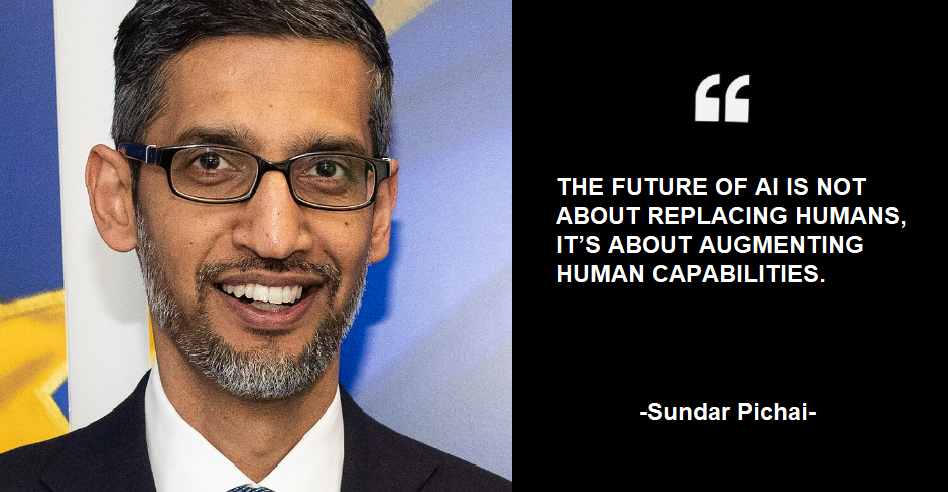Table of Contents
Introduction
Conversational AI is transforming how we connect, engage, and exchange information. Businesses are moving beyond basic chatbots, embracing intelligent systems that understand, process, and respond with human-like precision and empathy.
Conversational AI is revolutionizing the way brands engage with their customers. Its ability to interact through both voice and text makes it a powerful tool for enhancing customer satisfaction and boosting operational efficiency.
This shift represents a significant leap from scripted replies to authentic, context-aware conversations—effectively bridging the gap between human empathy and machine intelligence.
What is Conversational AI?
Conversational AI is all about the technology that allows machines to chat with us in a way that feels natural, whether through text or voice.
- It brings together various AI elements, like Natural Language Processing (NLP), Machine Learning (ML), and speech recognition, to grasp what we mean and provide responses that sound human.
- Unlike the old-school chatbots that stick to rigid scripts, Conversational AI systems are always learning and evolving
- They leverage data insights to improve their understanding, making conversations flow better and feel more relevant to the context.
In short, Conversational AI goes beyond just machines that can talk; it’s about fostering smooth and meaningful communication between people and technology.
How does Conversational AI work?
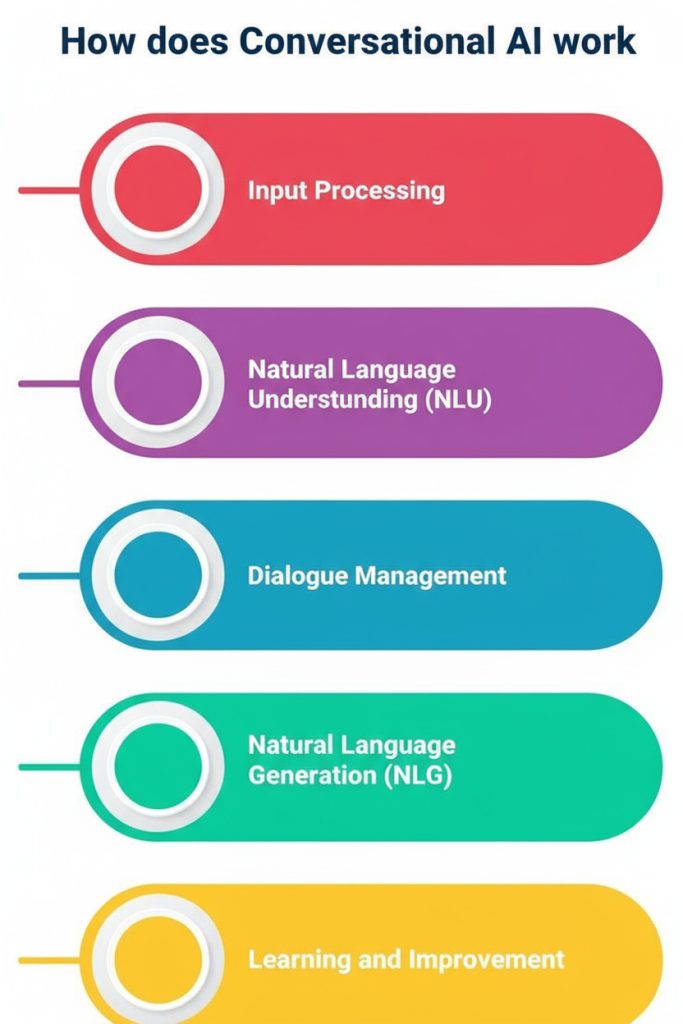
Conversational AI works through an intelligent process that allows machines to interpret human language, understand context, and respond meaningfully. Here’s how it functions step by step:
- Input Processing (Understanding the Query): When a user types or speaks, the system captures this input through text or voice recognition. Speech-to-text conversion is applied for voice queries, allowing the AI to process the message linguistically.
- Natural Language Understanding (NLU): The AI breaks down the input to identify the user’s intent (the goal behind the message) and entities (specific details like names, dates, or locations).
- Dialogue Management (Decision Making): Once the intent is recognized, the dialogue manager decides the next step—whether to fetch data, ask a follow-up question, or act.
- Natural Language Generation (NLG): The system then formulates a coherent, natural response. NLG ensures the AI replies in a tone and structure that feels human-like rather than robotic or scripted.
- Learning and Improvement: Every interaction trains the system. Using Machine Learning (ML), Conversational AI learns from previous conversations, refining its accuracy, context understanding, and personalization over time.
Benefits of Conversational AI in Business
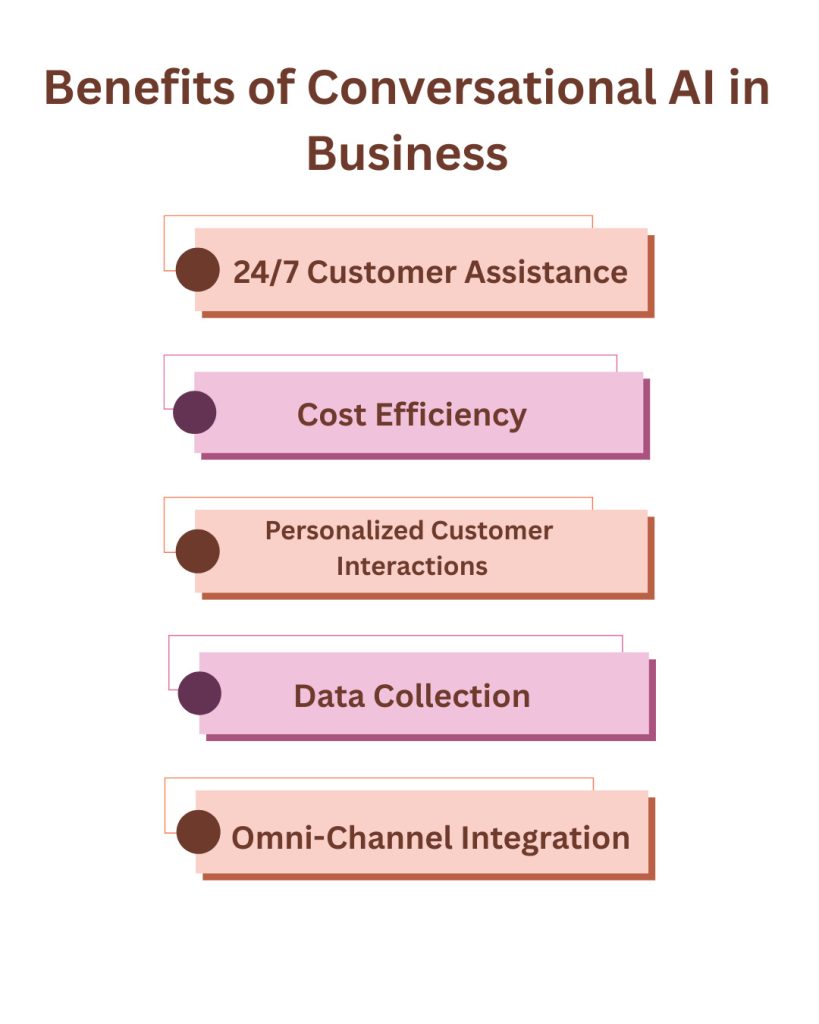
Conversational AI offers so much more than just quick replies—it enhances efficiency, personalizes experiences, and fosters stronger relationships with customers. Let’s dive into some of the most significant benefits:
- 24/7 Customer Assistance: With conversational AI systems working around the clock, customers can get immediate assistance whenever they need it, no matter where they are.
- Cost Efficiency: By automating routine inquiries and basic service tasks, businesses can significantly lower their labor costs.
- Personalized Customer Interactions: AI-powered chat systems can analyze user behavior and preferences to provide tailored recommendations and responses. This leads to more relevant, engaging, and emotionally intelligent interactions.
- Data Collection: Every conversation produces valuable data. Businesses can sift through these interactions to identify customer needs, spot market trends, and gauge satisfaction levels.
- Omni-Channel Integration: Conversational AI can be seamlessly integrated across various platforms, ensuring that customers enjoy a consistent and unified experience.
Use of Conversational AI across Industries
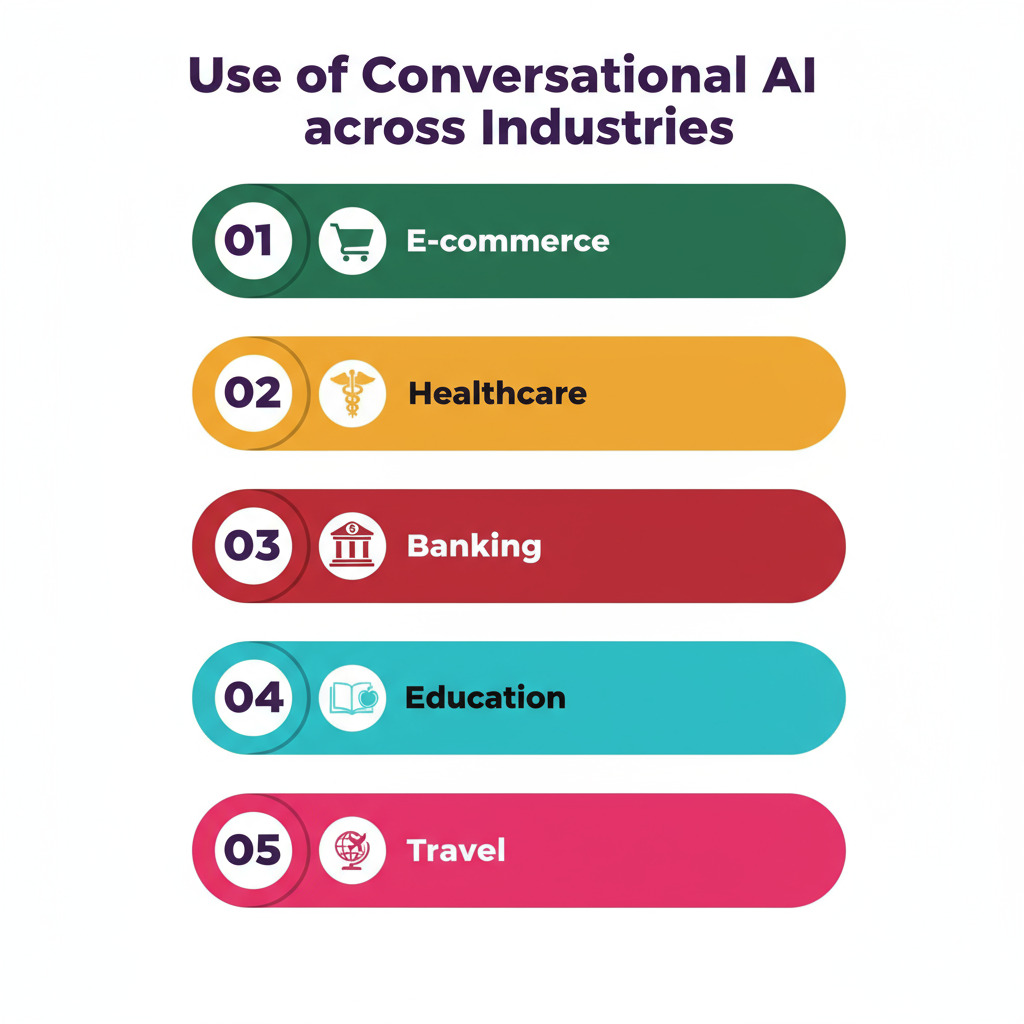
Conversational AI is shaking things up across various industries, making communication smoother and boosting customer experiences. Let’s dive into some of the key areas where it’s making a real impact:
- E-commerce: AI chatbots are like your personal shopping buddies—helping you find products, track orders, and even suggest items just for you. This not only increases sales but also makes online shopping a breeze.
- Healthcare: Conversational AI is a game-changer for patients, helping them book appointments, remind them to take their meds, and provide info based on their symptoms.
- Banking: Virtual assistants are there for customers to check their balances, transfer money, or get a grip on loan options, all while keeping things secure. AI chatbots play a crucial role in spotting fraud by flagging unusual fraud and alerting users.
- Education: AI-powered tutors and chat assistants are a great help for students, offering quick answers, personalized learning suggestions, and tracking their progress.
- Travel: Conversational AI makes booking trips easier, keeps travelers updated on their itineraries, and offers support in multiple languages.
Tools and Platforms for building Conversational AI

Choosing the right platform is essential for creating conversational systems that are scalable, smart, and aware of their context. Here’s a look at some of the leading tools and frameworks that are making waves around the globe:
- Google Dialogflow: Renowned for its powerful Natural Language Understanding (NLU) and flexibility in integration, Dialogflow allows developers to create both voice and text-based interfaces.
- IBM Watson Assistant: IBM Watson is recognized for its cutting-edge AI features, providing robust analytics, support for multiple languages, and top-notch security for enterprises.
- Microsoft Bot Framework: This platform offers a comprehensive environment for building, testing, and deploying conversational bots. It integrates smoothly with Microsoft Azure, making it a strong choice for developers working with Microsoft.
- Amazon Lex: Created by Amazon Web Services, Lex powers Alexa and features advanced speech recognition and NLU capabilities.
Practices for Implementing Conversational AI
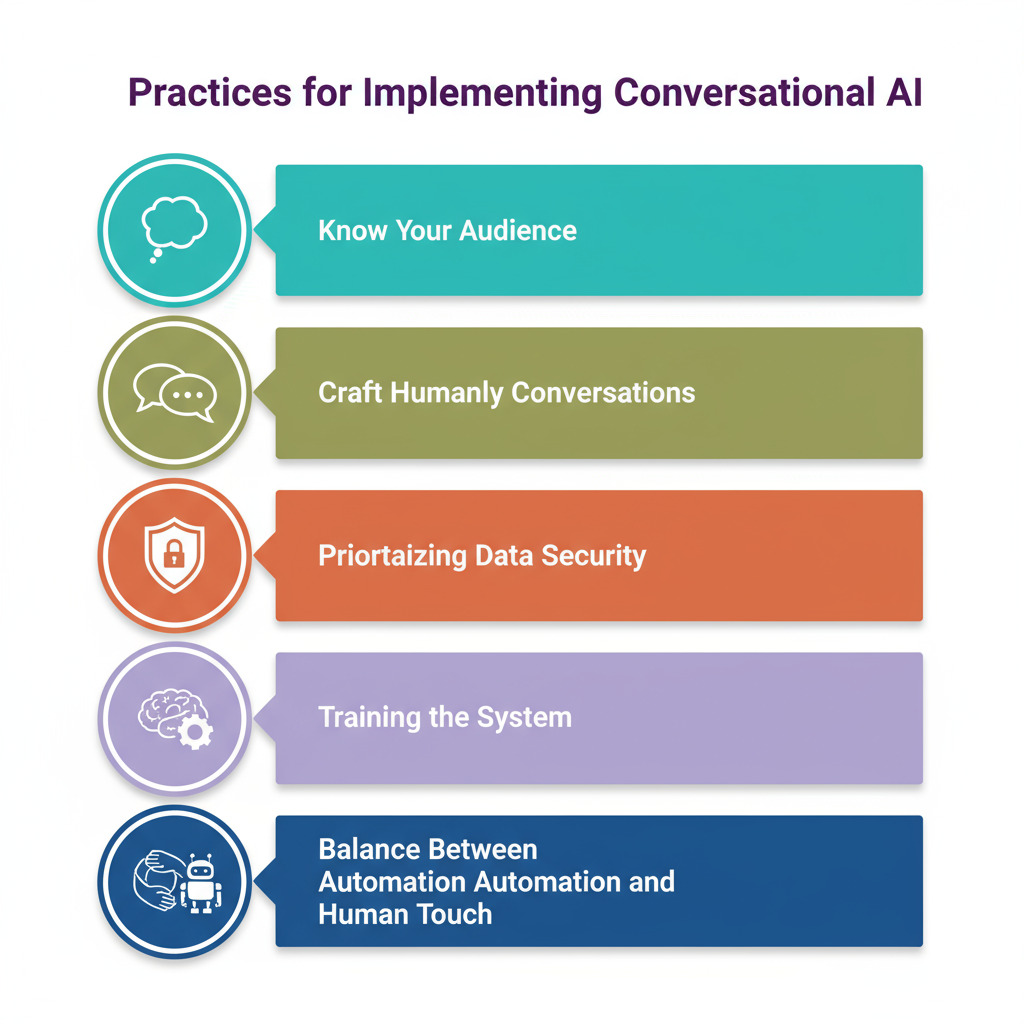
To really make Conversational AI work for your business, you need a solid strategy in place. Here are some key best practices to help you unlock its full potential:
- Know Your Audience: Begin by figuring out what users truly need and the challenges they’re facing. Customize conversational flows to align with user behavior and expectations.
- Craft Humanly Conversations: Embrace natural language, vary the tone, and show empathy to create a more engaging experience. Adding a bit of small talk or personalized greetings can really boost user interaction.
- Prioritising Data Security: Protect user information with encryption and clear consent policies. Adhering to global standards like GDPR builds trust and safeguards both customers and the brand’s reputation.
- Training the System: Conversational AI should grow and adapt with every interaction. Regularly review conversation logs, refresh intent libraries, and retrain models to enhance accuracy and keep the experience fresh.
- Balance Between Automation and Human Touch: While AI is great for handling routine questions, more complex or sensitive issues should be seamlessly passed on to human agents.
Future Of Conversational AI
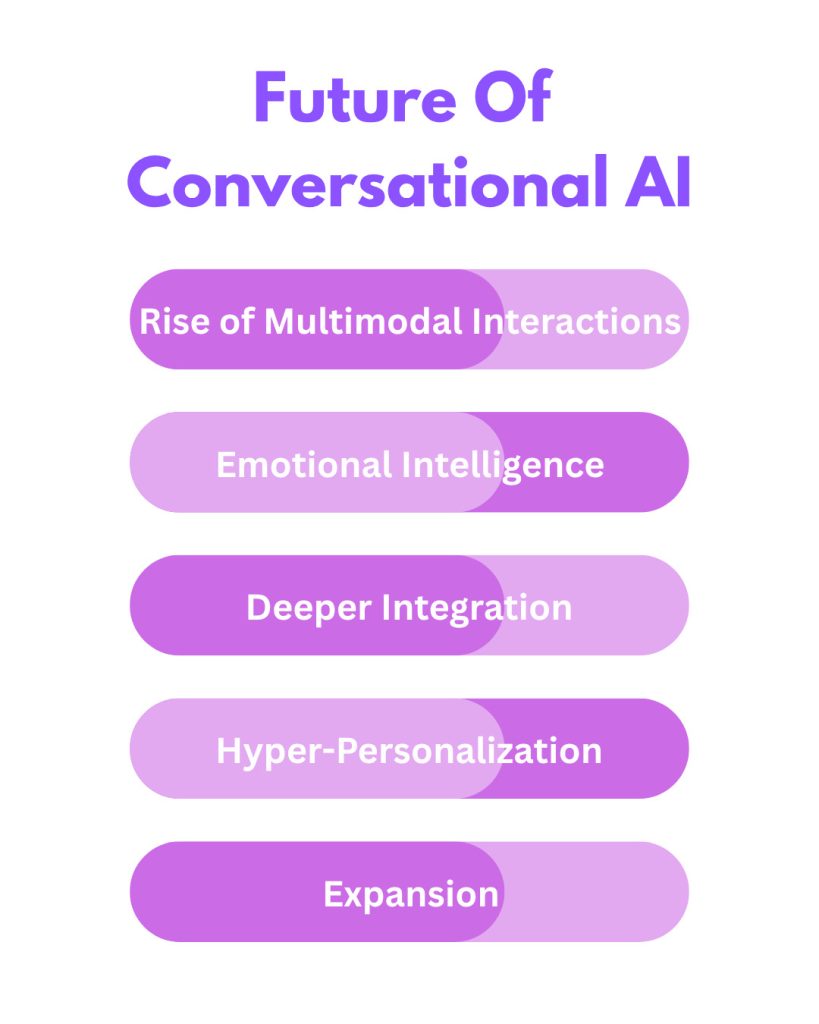
The next era of Conversational AI will push beyond text and speech into brilliant, emotionally aware systems.
- Rise of Multimodal Interactions: Future AI systems won’t rely solely on text or voice; they’ll combine gestures, images, video, and tone recognition to enable richer and human-like communication.
- Emotional Intelligence: Advanced sentiment analysis will allow AI to detect user emotions, stress levels, and mood. By adapting users’ tone accordingly, Conversational AI will feel more empathetic.
- Deeper Integration: With the power of Generative AI, conversational systems will create more natural, context-aware, and creative responses, shifting from scripted replies to dynamic, free-flowing conversations.
- Hyper-Personalization: AI will use behavioral data to anticipate user needs before they’re expressed, offering recommendations, support proactively. This predictive intelligence will redefine customer experience.
- Expansion: Conversational AI will become embedded in homes, cars, workplaces, and education systems. From personal wellness tracking to voice-driven learning, it will seamlessly blend into daily human routines.
Conclusion
Conversational AI has evolved from a simple automation tool into a cornerstone of modern communication. Its ability to understand language, emotion, and context allows businesses to connect with customers in more meaningful and efficient ways.
Conversational AI combines data-driven insights with human-like interactions to enhance customer experiences and streamline operations. Organizations that use it effectively achieve greater efficiency, scalability, and customer loyalty.
As technology advances, Conversational AI will become smarter, more intuitive, and more human. Businesses that adopt it now will shape the future of digital engagement.
Deepak Wadhwani has over 20 years experience in software/wireless technologies. He has worked with Fortune 500 companies including Intuit, ESRI, Qualcomm, Sprint, Verizon, Vodafone, Nortel, Microsoft and Oracle in over 60 countries. Deepak has worked on Internet marketing projects in San Diego, Los Angeles, Orange Country, Denver, Nashville, Kansas City, New York, San Francisco and Huntsville. Deepak has been a founder of technology Startups for one of the first Cityguides, yellow pages online and web based enterprise solutions. He is an internet marketing and technology expert & co-founder for a San Diego Internet marketing company.

